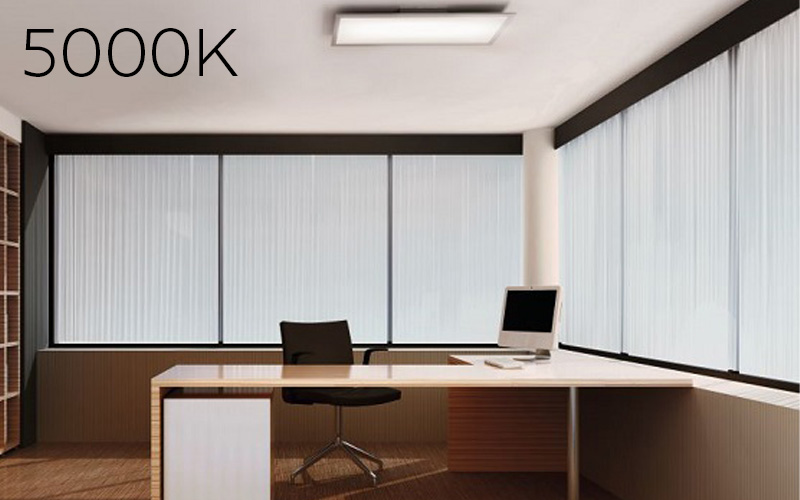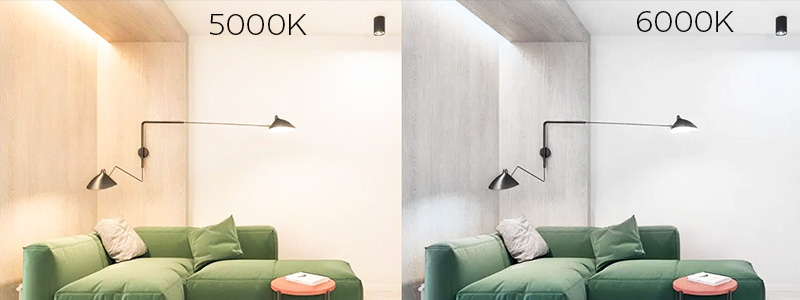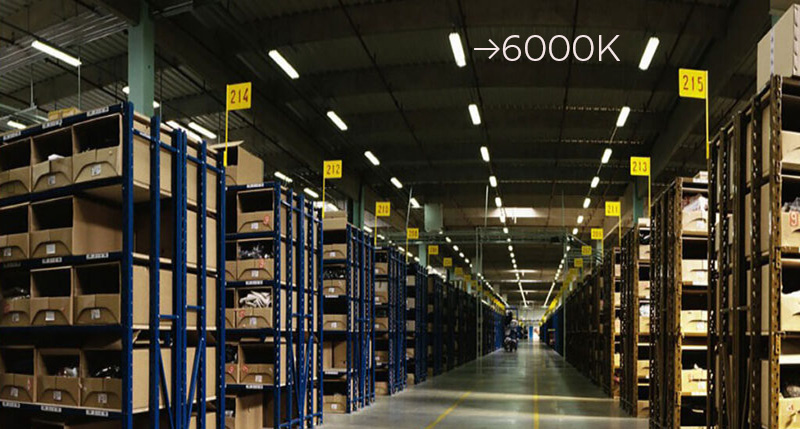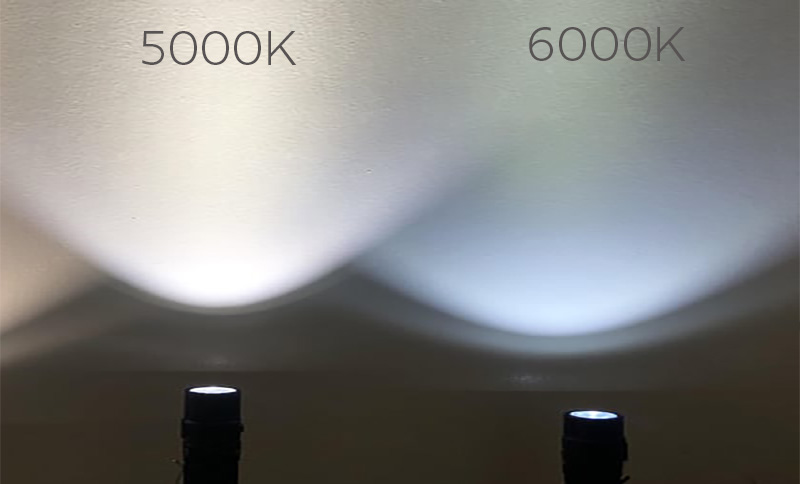Color temperature is a parameter that describes the color of a visible light source, measured on the Kelvin scale (K). In simple terms, it is the hue of the light as perceived by our eyes. When the Kelvin value is higher, the light is cool-white or bluish; when the value is lower, the light is warm-yellow or yellowish. And the correlated color temperature (CCT) is used to describe the color of light sources whose spectral distributions are not exactly the same as the blackbody radiator (a blackbody is a theoretical construct that absorbs all incident radiation perfectly and emits light solely based on its temperature).
When we talk about the specific value, we’re actually talking about correlated color temperatures (CCT). Generally speaking, 2000K-2200K is warm yellow, 2700-3000K is warm white, which is also called soft white ; 3500-4000K is natural white; 5000K-6000K is cool white (daylight), and 6500K-8000K temperature is cold white.
Different color temperatures can create different atmospheres to meet different functional needs. For example, warm yellow light in the bedroom creates a warm and cozy atmosphere, so that people can sleep comfortably; while the cool color temperature in the study creates a bright and light feeling, so that people can concentrate. Grasping the nuances between various color temperatures is essential for harnessing their potential to craft spaces with distinct ambiances and purposes.
In this blog we wil discuss the difference between 5000K and 6000K. 5000K and 6000K are both defined as cool white color temperature. What are the subtle differences between them? 5000K vs 6000K which is brighter? What does 6000K mean in lighting? What is the difference in application and how should we choose? In the following paragraph, we will explore each one of them.
What is 5000K LED light?
What color is 5000K? Although 5000K color temperature is defined as cool white color temperature, falling in the spectrum, 5000K light color is a more balanced, neutral pure white color, which is close to horizon daylight. 5000K lights emit a pure white which has more balanced brightness. Because of the balanced brightness, 5000K LED strip light is more comfortable that is suitable for various spaces to create a light and pleasant atmosphere.
Maybe someone will ask how many lumens is 5000K, but these are two different concepts. Lumens represent the total amount of visible light emitted by a light source per unit of time, while 5000K refers to the color temperature of the light source. 5000K colour temperature is close to the color of horizontal daylight. If two light sources have different lumen output, even if their color temperatures are both 5000K, their brightness will be different. The higher the lumen outpout, the brighter the light.

What is 5000K lighting used for?
5000K LED lights provide bright illumination and creates a relaxing atmosphere for offices, outdoor parks, sidewalks, or kitchens and bathrooms in the home.
- Supermarkets or retail stores: 5000K LED shop light emits a balanced neutral white light that creates a relaxing and inviting atmosphere that not only allows customers to see the details of the merchandise, but also allows them to shop in a relaxed atmosphere.
- Security Lighting: 5000K LED lighting fixtures emit a bright, clear light, including LED spotlight, LED floodlight etc., which is suitable for parks, sidewalks, porches and garden to provide safe and bright lighting.
- Offices: The balanced brightness of 5000K LED light, close to horizontal daylight, keeps people relaxed and calm and helps improve work efficiency.
- Residential lighting: The 5000k indoor downlight with a neutral white light creates a relaxing and welcoming atmosphere and is suitable for use in the kitchen or bathroom in a domestic environment.5000K lighting In kitchens with light-colored countertops and white cabinets, the pure white light of 5000K lighting not only harmonizes with the style of the kitchen, but also helps to see the details of the food. The bright, pure white light from 5000K daylight LED helps create a relaxing atmosphere in bathrooms that require deep relaxation.

Pros and Cons
The advantages and disadvantages of color temperature are relative concepts in relation to personal preferences and environmental needs.
Pros
- Naturalness and freshness: 5000K color temperature is similar to horizontal daylight, creating a fresh and natural atmosphere.
- High applicability: 5000K LED lights are pure white, well-balanced lights, which can be used for residential lighting, outdoor lighting, commercial environment or office, etc.
- Calmness and comfort: The pure white light emitted by 5000K LEDs simulates the feeling of horizontal daylight, which can calm the mind.
Cons
- Eye fatigue: Does cool white light is harmful to our eyes? Compared to warm yellow light, 5000K LED lights emit cool white light is more likely to make the eyes fatigued.
- Less concentration: 5000K color temperature lighting is more balanced, creating a more relaxed and natural atmosphere, is not applicable to hospitals or workshops that require a high degree of concentration.
What does 6000K mean in lighting?
6000K LED light emits a cool white light with a slight blue tint, similar to vertical daylight. This cool white color temperature is often associated with clarity, focus and productivity. 6000K LED light color is bright and high contrast, which has focus, and visibility enhancement capabilities.

Is 6000K LED too bright?
6000K LED lighting emits a cool white light with a slight blue tint, similar to vertical daylight. Therefore, in terms of visual effect, 6000K LED lighting fixture will give a bright feeling.This cool white color temperature is often associated with clarity, focus and productivity. 6000K cool white light is bright and high contrast, which has focus, and visibility enhancement capabilities. 6000K LED shows details clearly, and are typically used in hospitals or workshops where high illumination is required.
However, the brightness of light is determined by the number of lumens. The brightness of a 6000K lights will also vary from lumen to lumen. Therefore, whether a 6000K LED is “too bright” is determined by the number of lumens. The 6000K color lamp do emit a bright, cool light to meet the need of high clarity.
6000K LED light application
Because 6000K LED light color is cool white with a blue tint similar to vertical daylight, which have high color rendering. Therefore, 6000K lighting are often used in environments where focus and clarity are required.
- Functional Lighting: Is 5000K or 6000K better for garage? In general, the 6000K LED lamp provides high contrast and clarity of light, while 5000K lights provide a more balanced light. For garages where clarity and focus are needed, 6000K LEDs are preferred over 5000K LED lights. Color temperature 6000K is cool blue white that helps people improve their concentration and get work done more efficiently, making them suitable for use in garages and studios where focus and clarity are needed. Besides, the color 6000K lighting is usually applied to the car headlight because it offers the clear and cool white light.
- Spotlight Lighting: The Color Rendering Index (CRI), is a gauge of a light source’s capacity to accurately render the colors of objects. A source with a high CRI delivers a more precise representation of an object’s true colors. Color temperature and CRI are complementary. Maintaining a balance of color temperature and CRI can create specific lighting effects. For example, when displaying art paintings, which usually require high CRI daylight color temperature lighting. A high CRI 6000K color temperature LED light is a good choice. 6000K color LED emits a cool white light with a bluish tint that highlights the textures and details of the merchandise on display, making 6000K lighting ideal for highlighting displays such as jewelry and artwork.
- Industrial and Medical Lighting: Bright and high contrast, 6000K daylight white LED can be used in factories or workshops, for example, to improve worker productivity. In addition, the 6000K emits light with a bluish tint, close to vertical daylight, which is calming and focused, and can be used in healthcare settings such as hospitals and clinics to improve the concentration of healthcare workers.
- Photography and Specialized Lighting: The 6000K white lights produce light similar to vertical daylight, so they can be used for photography and other special lighting needs, helping to accurately display color and detail.
Pros and Cons
Color temperature benefits and drawbacks are relative ideas based on individual preferences and environmental requirements.
Pros
- Efficiency improvement: 6000K color temperature is similar to vertical daylight, can improve people’s attention, used in factories or hospitals and other places that require a high degree of concentration.
- High clarity: 6000k color temperature is white with a bluish tint, this color has high clarity and can restore the color and details of things.
- Safety Lighting: 6000k led lights are bright and clear, used in parking lots or outdoor walkways to help improve safety.
Cons
- Dazzle In a home or hotel environment where a cozy atmosphere is needed, the cool white light of 6000K may seem too harsh.
- Rest disturbance: Although 6000K light can improve human concentration, but if exposed to such lighting for a long time, it will make people mentally stimulated, which in turn affects rest and sleep.
5000K vs 6000K Lights
What is brighter, 5000K or 6000K? As we can see from the table, 6000K lights emit a bright, bulish cool white light , close to vertical daylight. The 5000K LED lights emit a balanced pure white light, close to horizontal daylight. Therefore, visually, the LED 6000K light emits a cooler light and will appear brighter than the 5000K LED . In order to meet specific lighting needs, LED 6000K lumens output are generally higher than LED 5000K in lumens, so 6000K lights will also be brighter. However, there are actually some 5000K daylight LEDs that have higher lumen counts than 6000K lamps, and sometimes they are brighter than 6000K LED. Overall, 6000K lighting is generally brighter than 5000K LED light.

6000K lighting emits cool white light with blue tint, which is similar to vertical daylight. Daylight white and soft white is different because soft white is warm white white daylight white is cool white. This feature of daylight 6000K LED creates a cold and sterile ambiance, making 6000K LED light suitable for hospital and factory. 5000K light color is pure white, which is relatively soft and light, but also bright and clear. Therefore, this characteristic of lighting is suitable for offices or retail shops, etc. 5000K bright white lighting not only allows people to focus on the work, but the bright tone makes the mood can remain peaceful.
| Feature | 6000K LED Lighting | 5000K LED Lighting |
| Light color | Cool white with blue tint (vertical daylight) | Pure white ( horizon daylight) |
| Brightness | High brightness | Balanced brightness |
| Ambiance | Cold and harsh | Neutral and inviting |
| Function | High concentration | Lack of concentration |
Conclusion
Although 5000K and 6000K both fall within the cool white color temperature range, they are still a little different. Therefore, choosing the right color temperature based on these different characteristics helps create efficient and enjoyable spaces.